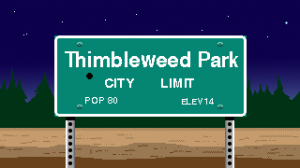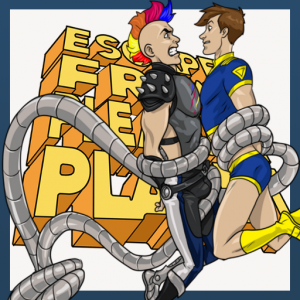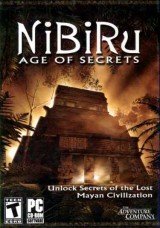Review for Doorways: Holy Mountains of Flesh

While it doesn’t have a number in the title, you should probably know that Doorways: Holy Mountains of Flesh is really the fourth (or third, depending on your math) and final episode of the horror-adventure series. If you go into this game without prior knowledge, expect to be completely, utterly lost. If you go into it with the requisite prior knowledge, you’ll only be utterly lost in a story that steadfastly refuses to make even a lick of sense even now. So, okay, maybe it’s NOT that important to know it’s #4… or 3. As a sequel, practically no context is provided to bring players up to speed (or, in fact, to explain anything at all), and as a finale, it does little to illuminate its paranormal premise and offers no closure whatsoever. I give credit to indie developer Saibot Studios for seeing Doorways through to its end – it’s a difficult proposition for any small team, but particularly so in a series that just isn’t all that good.
You might think that by the last title in a series, it would have found its stride and settled into a comfort zone, but Doorways has always been a game in search of an identity. In the two-part Prelude, we were presented with an intriguing supernatural setup and a genuinely unnerving atmosphere, let down by a barely-coherent story and uninspired gameplay. For the next release, The Underworld, the developers decided to ease back on puzzles and ramp up the stealth and survival horror mechanics. Holy Mountains of Flesh, in turn, feels more like three distinct games in one, each with a radically different tone and gameplay focus – no doubt a by-product of its lengthy gestation period in Early Access. A certain degree of variety is always welcome, and this episode is probably an incremental step up from its predecessors, but it still very much feels like a game that just doesn’t know what it wants to be.
Whether you’ve played the earlier Doorways adventures or not, your first reaction (and probably many subsequent reactions) is going to be “What the hell?!” In this initial instance, however, it’s entirely justified in a literal sense. With absolutely zero introduction, or even a recap to set the stage, you’ll find yourself descending down a sickeningly deep shaft that opens into a nightmarish world of floating rock structures, rumbling red storm clouds, a derelict village, and an archway lined with skulls. It’s a great way to start, really, as you’ll be instantly immersed in the horrifying environment and eager (if nervous) to discover more.
But you’ll never really discover that much more, and this has been a critical failing of the entire series so far. To say there are “plot holes” in Doorways would be a gross understatement. It’s more like one massive hole into which tiny plot points are dropped randomly and inexplicably, few and far between. As best I can understand it, players control Thomas Foster, some kind of psychic investigator probing the crimes of demented killers who have escaped regular justice. Where, physically, is this taking place? Dunno. In the mind of the killer, maybe? Perhaps in Foster’s own head? How, then, to explain the odd journal entries scattered around, some written by the culprit(s) and some by Foster himself? Possibly you’re on an astral plane of some kind, but if this isn’t big-H “Hell” itself, it’s certainly a little-h variation of it. Letting someone rot there alone for eternity would be punishment enough for any crime.
Entirely by coincidence, I just rewatched the movie The Cell, in which Jennifer Lopez enters the subconscious reality of a comatose and wickedly psycho Vincent D’Onofrio to discover a secret. Not a very good flick, but I could roll with the concept because it was properly established. Here? Nothing. You’re just dropped into a surreal representation of the killer’s town. Or rather, in this case, plural killers, as it’s not one but an entire family of three (so much for being in one person’s mind). And instead of merely seeking information, the end goal is to KILL the killers, in the most sadistic manner possible. How is this supposed to impart justice – or rather, exact retribution – in the real world? Beats me. Not only are these questions not answered in any of the four games, they’re never even asked. In fact, this episode prefers to spend its rare moments of exposition toying with the notion that the agency Foster works for is trying to screw him over by trapping him there (wherever “there” is) too. Given the sociopathic viciousness of his execution methods, I don’t blame them. Regardless, other than setting up an entirely anticlimactic epilogue, this meta diversion serves no narrative purpose whatsoever, and is certainly no substitute for telling the main story adequately.
However you got wherever you truly are, you’ll find yourself in a kind of nightmare version of El Chacal, an Argentinian mountain village where Juan Torres (aka “The Roaster”) and his wife led a cannibalistic cult devoted to the “Saint of the Flesh”, while their mentally handicapped son terrorized those who picked on him at school. The labyrinthine underworld hub consists mainly of empty shacks, crumbling ruins, and twisting stone passageways. You can poke about in the abandoned homes, but other than hearing trace sounds of their former inhabitants that are neither scary nor interesting (an old man coughing, children playing, a sick person throwing up), there’s little to do except make your way to three particular structures in order, each representing one of the Torres family members. Sometimes the only way to reach your next destination is by jumping from platform to moving platform, some of them crumbling beneath your feet. (This won’t be the last time you’re required to perform feats of dexterity, but more on that later.) Each time you return from a mission at one of the main buildings, the town becomes further overrun by slimy, blood-red tentacles. Why, you may be thinking? Stop it; you’re asking too many questions.
You’ll start out in the school, where “retarded” (as the game describes him) young Jeronimo was bullied by fellow students and had good reason to hate the other children – though surely not reason enough to apparently slaughter them all. I say “apparently”, because other than the odd despairing note and a few visions of horrific aftermath, there’s really no evidence of any wrongdoing. This is a common theme running throughout the game. We’re to believe that we’re hunting down Very Evil People™, without much actual proof of their nasty misdeeds. I should have wanted those monsters punished as much as Foster by the time he tracked them down, but I almost felt sorry for them, so little was I convinced of their heinous crimes.
Hole plots (not a typo) aside, once you suspend enormous amounts of disbelief over what’s missing, what’s actually here is more satisfying, if not without problems of its own. What’s most surprising about Holy Mountains of Flesh is how different the gameplay is throughout its three acts. The school is the most Doorways-ish of the lot, blending a little light puzzling into a lot of shadows with lurking horrors. Other than one pedal-to-the-metal chase sequence, the few Silent Hill-esque abominations behave themselves if you stick to the light. (If you’re even thinking about asking who or what these are, and why they’re haunting the building, then give yourself a slap.) One puzzling sequence tasks you with penetrating the treacherous darkness, but unfairly so, as a certain hotspot won’t highlight unless every element is in its predetermined position, even if there’s no reason for that to be necessary. A chemistry puzzle, too, requires a solution to be performed just so, with misleading feedback to other partial attempts.
The second setting caught me completely off guard. After roaming around the brightly-lit, not-at-all-scary posh family mansion and solving an all-or-nothing sequencing puzzle, the remainder of the chapter consists of a giant slider puzzle, in which a board-style version of the standard tile challenge results in actual shifts of the environment. I alternately found this challenge to be both clever and infuriating. I loved the concept and admired its ingenuity, but cursed its insistence on hiding necessary objects in order to complete it. This leads to all kinds of trial-and-error with extensive legwork in between, which stops being fun long before the stage is complete. And while I’m no mechanical engineer, even now I question some of the room connections needed to proceed. As an adventure gamer, I have no issue at all with being confronted by a lengthy, multi-tiered puzzle, but I do question its appropriateness here. Even suppressing the urge to ask (don’t go there) why there’d be such an obstruction governing the house, is this what horror fans want in the middle of their game? Though it does take a darker turn towards the end, players could easily spend well over an hour working through this section alone, with very few signs of creeps or scares.
Perhaps intent on making up for lost time, compounding the problem is the atrocious platforming sequence to escape the mansion. First-person jumping scenarios are usually a disaster, and Holy Mountains of Flesh is no exception. To its credit, this game adds a third-person option that you can switch to at any point. Unfortunately, this mode is even worse when you need it the most, because the animation is stilted, the controls too clunky. It’s extremely easy to miss one jump, particularly as you’re scrambling through the dark with a spectre on your tail, and if you fall or die, you go all the way back to the beginning to try again. I play many action games, and I was frustrated at how often I had to retry it. Still, my irritation was manageable the first time I got to the end… when the game decided to completely break one of its own rules. Only after I’d completed it two more times (with many, many false starts in between) did I bother to try something that had been blatantly refused in every other circumstance. Grrrr.
The final level in a temple is also somewhat puzzle-centric, with a pair of identical pillar-shifting challenges following a bit more (but thankfully far less strenuous) platforming. There’s nothing especially frightening here either, until a trail of blood and bodies leads you right to an end boss. Though technically more of a “puzzle” than a fight, succeeding here is largely a matter of perseverance and a deft hand rather than intelligence. The trick is to survive long enough to figure out what to do, but expect to be skewered time and time again as you experiment before finally working it all out. At least there’s a checkpoint halfway through, so you aren’t always starting over from scratch.
The three main acts are capped by some of the ugliest cutscenes I’ve seen in some time. This is in contrast to the game itself, which is actually quite attractive. Textures aren’t the crispest up close, and lots of elements (paintings, crucifixes, books) are reused, but in general the 3D environments are pretty slick. The hub world is suitably creepy; the school is rusting, peeling, littered and run-down; and the mansion is luxurious with its high ceilings, marble floors, grand staircase and chandeliers. Lighting plays an important role – or rather, the lack thereof, designed to increase suspense, though not as often as you might expect. There’s not a lot of animation, but enough flickering torches, billowing smoke, and rolling clouds inject a little dynamism into the deserted town. There are a few jump-scare moments of legitimate terror, though these become less frequent the further you progress.
Music is used sparsely, relying mainly on haunting tonal sounds to set the appropriate atmosphere. There’s no one to speak to, but Thomas reads his own journal entries aloud as you discover them, and the voice-work sounds completely staged. Rather than a man recounting his own thoughts in a dismal and horrifying place, it comes off more like over-the-top movie trailer camp. Surprisingly for a horror game, I rarely noticed much ambient sound outside of my own footsteps, except for some thunder and a few faint wails and moans that didn’t seem to emanate from anyone. Then again, so much of the game takes place in a non-frightening environment, more really wasn’t needed. Who needs spooky sounds when you’ve solving a slider puzzle or exploring empty houses?
Apart from the addition of the third-person mode, which I switched to as a curiosity before quickly returning to first-person for good, the mechanics work exactly like the previous games. Though you can only leap over things the game wants you to, the jumping is largely adequate other than the mansion’s diabolical sequence. You can use either the standard mouse/keyboard combo or a gamepad, each functioning just as well as the other. Hotspots highlight when you draw close, but there really aren’t all that many things to interact with along the way. My only issues relate to the incredibly cumbersome inventory system, which is thankfully mitigated by hotkeys to access new items directly, and the unannounced ability to climb. I was stuck far too long at one point, simply because I had no idea I could climb a fence just by pushing myself into it. Having seen no hotspot highlighted when I drew near, I wrongly assumed that moving forward would result in nothing more than a face full of chain link.
In writing this, it seems as if the criticisms are piling up higher than my overall dissatisfaction with the game. I actually had a decent time throughout much of my six or seven hours spent playing – not counting two peeks at a walkthrough that prevented an abundance of hopeless dead time. Outside of the story failings, which are really inexcusable after three/four complete games, there’s some solid adventuring to be found in this hellish town. The problem is that the game takes one misstep backward for every step forward. Excellent puzzle ideas are hindered by flawed implementation, while the dramatic shifts in gameplay are likely to alienate many players. Were hour-long, fright-free puzzles the missing link for survival horror fans? Were adventure gamers clamouring for punishing platforming sequences and boss fights? There’s a market in the middle, to be sure, but even for them, Doorways: Holy Mountains of Flesh is too uneven to fully embrace. There are things here to enjoy, but be prepared for an uphill climb.































